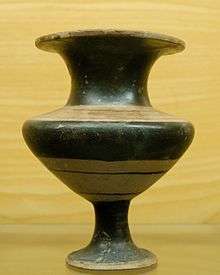Lydion
The lydion (Greek λύδιον; plural lydia) was an ancient Greek vase shape. The shape may have been of Egyptian derivation.[1]
As indicated by its name, the lydion originated in Lydia, but was also adopted by potters in Greece. A small spherical perfume container, lacking handles, it was especially popular in East Greece. The vessel stood on a narrow, relatively high foot, cylindrical or conical in shape. The neck could be of varying length; it met the body at an acute angle. The lip was horizontal. Usually, the lydion was decorated with stripes. In Athens, it was only produced rarely; figural decoration was even rarer.
Bibliography
- Wolfgang Schiering: Die griechischen Tongefässe. Gestalt, Bestimmung und Formenwandel. 2. edn. Mann, Berlin 1983, S. 151 ISBN 3-7861-1325-4 (Gebr.-Mann-Studio-Reihe).
gollark: ... wow.
gollark: Though admittedly not well. The sandbox is *slightly* broken in areas and may contain gravel.
gollark: PotatOS "works" much "better" than "that".
gollark: That sounds really "secure".
gollark: "Security" by banning access to those?
This article is issued from Wikipedia. The text is licensed under Creative Commons - Attribution - Sharealike. Additional terms may apply for the media files.
